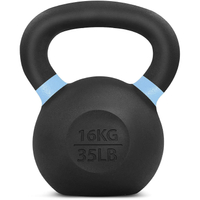I did 50 kettlebell swings every day for two weeks — here's what happened my body
The same move, every day for 14 days straight? I was amazed at the outcome

I do a lot of workout challenges — specific amount of reps of particular moves — and one of the last I did involved kettlebells, and I often use the weight at the gym too. It's versatile, raises your heart rate, and works your full body, which seems like a winner.
But when I was asked to undertake the challenge of 50 kettlebell swings every day for two weeks (why, that’s 700 swings, or, a lot, as we proud innumerates say). But challenges are, by their seductive nature, fiendishly hard to resist, so away I went.
How to do a kettlebell swing
The main reason I do kettlebell swings at all is because they are a superb full-body exercise, targeting the posterior chain (the muscle along the back of the body – not just the posterior/glutes, as the name suggests), as well as the lower body, core, and, to an extent, the arms and shoulders.
And this is an exercise that will get your heart pumping. It’s a move that asks a lot of the body but delivers, too. So before we dive into how two weeks of the full-body move went, here’s how to do a kettlebell swing.
- With your legs shoulder-width apart, hold a kettlebell in both hands, palms in and arms hanging straight down
- Engage your core, inhale and, with a slight bend in your knees and maintaining a straight back, hinge at the hips to swing the kettlebell back between your legs. This does not have to be an aggressive swing — you’re not trying to launch the bell like a cannonball
- To continue the movement, engage your glutes and push your hips forward to come into a standing position, allowing the momentum to swing the bell up in front of your chest. Keep your arms straight
- Hinge again at the hips to bring the kettlebell back between your legs, and continue your reps
The key things to remember are that this is not a squat movement, so do not bend those knees too much; and the swing comes from your legs and the snap of your hips at the top of the move. You’re using momentum, not your arm and shoulder muscles, to raise the bell.
One more thing to note before I get into the details: Tom’s Guide fitness editor Jane McGuire did a similar challenge some time ago of 100 kettlebell swings a day for a week. This, she pointed out, was an awful lot.
If you are new to kettlebell swings, please don’t start by doing them every day for a week, far less two weeks. And because form is so important with this move, it might be a good idea to check yours with a personal trainer if you have any concerns. And consult a medical professional if you have lower back issues first.
Choosing the right weight makes a difference
I used a 35lb kettlebell for this challenge. I use slightly heavier bells for deadlifts but this was a safe max for me at the moment with an exercise that requires a lot of movement, especially in the hips.
I usually do sets of 10 when I do kettlebell swings, so I expected this one to leave me breathless. And it did, at least initially. On the first day, I felt it intensely in my back, glutes, and, oddly, my quads.
This last aspect told me my form wasn’t quite right, so I focused on maintaining a straight back and snapping my hips when I stood upright. Bingo: back, glutes, and hamstrings.
This Yes4All Cast Iron Kettlebell has a wide, smooth handle that makes two-handed moves (like swings) easier, a flat, non-slip base and has a color-coded strip to indicate the weight — handy if you want to add several loads to your home gym setup.
My lungs got their act together, as well, and as the days went by, I found I could complete the set without feeling the desire to retire with a cold compress to a chaise longue, which is lucky because I don’t have one (a fact that pleases me greatly, to be honest).
It took me about 90 seconds to complete the move, but I managed to work up a pair of sweaty hands, which was a concern, as I was standing in front of glass doors. (This is the sort of thing you have to bear in mind when you’re exercising at home.)
If that bell had slipped from my despairing fingers, no pane of glass or supposedly sturdy door frame was stopping it. I intensified my hold — the move also works grip strength and, in my case, kept me alert.
Accidents in the home can happen easily, but throwing a kettlebell through a glass door is not something you can easily explain away to loved ones. Or pets.
I didn't get bored
I thought I’d become very bored of this challenge very quickly, but the opposite happened. I began to look forward to noting my improvement, which was down to better form. And this, after the first five days, was almost automatically good — it was smooth, I was hitting the right muscles, and I wasn’t left heaving for breath.
Towards the end of the challenge, I took a day off, owing to a 24-hour bug that at least had the good manners to clear up in the agreed time. The day after, I wondered if any residual weakness — or the mere fact I had missed a day — would have any negative effect, but my body came through for me.
The challenge had become part of my day and no part of me was complaining. Doing 50 kettlebell swings a day is by no means necessary for maintaining or developing fitness, but I found it surprisingly easy and enjoyable to fold into my daily routine. This is how habits are formed…
It eased my back tightness
I’ve had some back problems over the years, so I take care of it as best I can. Still, there are days when I wake up with some tightness that takes a few minutes to ease. I had no such tightness while doing the challenge. For that reason alone, I will keep up at-home kettlebell swings, though I will probably use a lighter weight.
My entire back feels stronger, which at the very least gives me the feeling of improved posture. I know it takes weeks to build visible muscle, but I find it hard to believe I did not develop some strength doing this move every day for two weeks.
Running got easier
When Jane did her kettlebell challenge, she felt it fired up her glute muscles before a run, and I had the same experience. I sometimes did the move before heading out and was better able to get into my stride (as is the case with any decent pre-run warm-up, of course), but I also noticed a cumulative benefit.
I feel I’m running with less effort than I have for quite a while, and my heel kick is much better. And that is a wonderful feeling. Useful, too, as I’m adding to my miles in preparation for warmer weather.
Will I keep it up? You bet
A full-body workout that helps me run better, improves my strength and cardio fitness, keeps my back in good working order — and doesn’t take long? Of course I’ll keep up this all-round winner, and I cannot recommend the move highly enough.
Obviously, you don’t need to do 50 every day, but give it a shot. You might love it. Take me, for example, I’m eyeing up the lighter 'bell right now and thinking, I’ve got a couple of minutes…
More from Tom's Guide
Sign up to get the BEST of Tom's Guide direct to your inbox.
Get instant access to breaking news, the hottest reviews, great deals and helpful tips.
John is a writer and editor based in London. He was worked for magazines such as Runner’s World, Men’s Health, Women’s Health and Cosmopolitan. A keen runner, what he lacks in ability he makes up for with enthusiasm and excuses.
You must confirm your public display name before commenting
Please logout and then login again, you will then be prompted to enter your display name.


